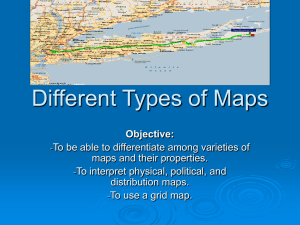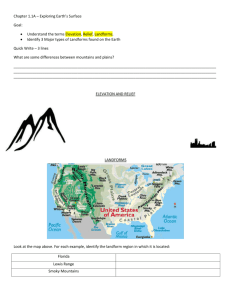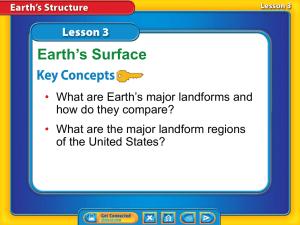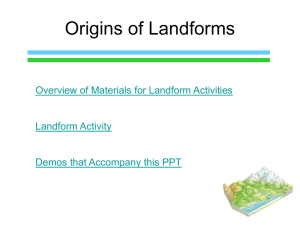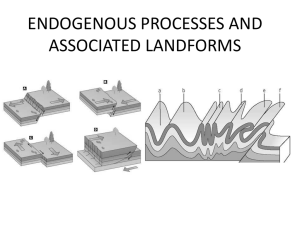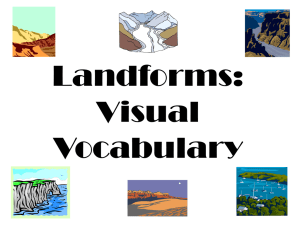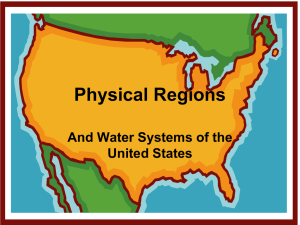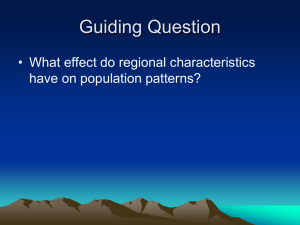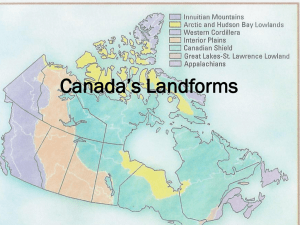Landforms - Miami Arts Charter School
advertisement
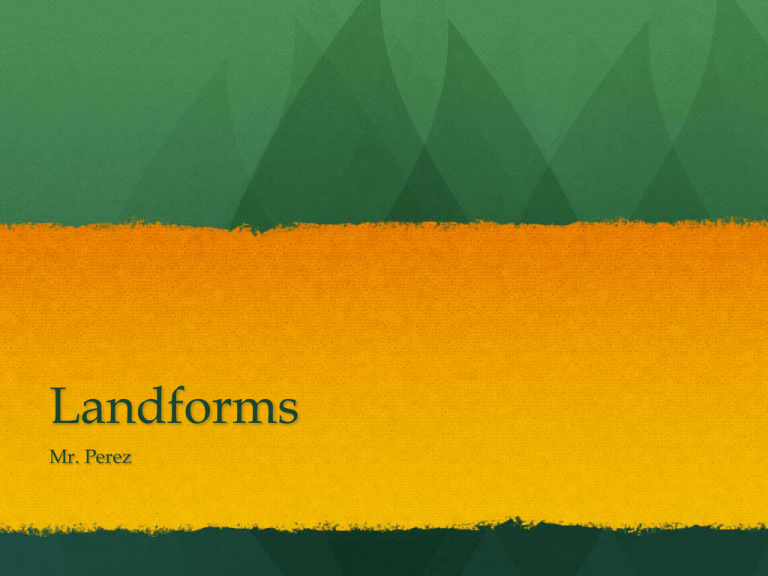
Landforms Mr. Perez What is a landform? A landform is a natural feature of the landscape or natural physical features of the Earth’s surface Examples include: Valleys Plateaus Mountains Plains Hills Beaches Canyons Deserts Rivers Straits Archipelago Peninsulas Swamps Lanforms Mountains Mountains are formed when two plates converge or collide and begin to rise Some times, mountains are formed by the process of weathering and erosion. Mountains are broken down by wind, water and ice This causes the shape of the rock to change Other times, mountains can be formed by volcanism Volcanism is any volcanic activity Examples of Mountains Rocky Mountains Himalayan Mountains Adirondack Mountains Plains Plains are broad, nearly level stretches of land that have no great changes of elevation Plains may be found along the coast or inland Coastal plains: generally rise from sea level until they meet higher landforms such as mountains or plateaus Inland plains: may found at high altitudes Flood plains are the floor of a river valley beyond the riverbed These are formed by mud, sand and silt that are carried off by the river as it erodes the land upstream Examples of Plains Plateaus Plateaus are large highland areas of fairly level land separated from surrounding land by steep slopes Some lie between mountain ranges Some are basaltic, forming from many lava flows Other are formed by upwarped folding Plateaus may also be formed due to eroding land Weathering and erosion take affect on the upland, creating slopes Examples of Plateaus Tibetan Plateau Island in the Sky- Utah Kukenan TepuiVenezuela Florida Landforms Florida consists of these major landforms: 1. 2. 3. 4. 5. 6. 7. 8. Beaches Aquifers Sinkholes Caverns Coastal plains Upland (hilly areas) Swampy Everglades Florida Keys (archipelago) (Peninsula) Beaches Beaches are formed by the constant battering of the ocean, wind and other natural conditions wear down the rock and other materials on shore Aquifers & Sinkholes Aquifers are bodies of permeable rock that can transmit or contain groundwater The major source of ground water supply in Florida is the Floridan Aquifer System, which underlies the entire state Sinkholes are natural draining systems formed by chemical weathering Limestone is dissolved, forming sinkholes Caverns Caverns are natural underground spaces large enough for humans to enter They form naturally by weathering of rock and often extend deep underground Upland (hilly areas) Upland, or hilly areas, are raised areas of land In Florida, hilly areas are found in the northern panhandle and central part of the state. Swampy Everglades Swamps are types of freshwater wetlands that have spongy, muddy land and a lot of water. Many trees and shrubs grow in swamps Before humans began developing land in South Florida, almost 11,000 square miles was covered in the swampy Everglades The Everglades is the only place where alligators and crocodiles can exist side by side (because of the salt and freshwater mix) Florida Keys (archipelago) An archipelago is a group or chain of islands clustered together in a sea or ocean. Some archipelago are formed due to volcanic activity, while others can form due to weathering and erosion of land The Florida Keys are an example of an archipelago Optional Project (for those who would like to boost their project grade) Create a 10-15 slide PowerPoint about 3 or more landforms following these guidelines: 1. The first slide should include: 2. Include the following information about your landforms: 3. 4. Name, Date due, period Name of Landforms included in your PowerPoint Description, how they are formed, picture(s), examples of your landform on Earth The last slide should include a list of websites or references of where you found information Email your PowerPoint presentation to eperez@miamiartscharter.net by A: 1/11 B: 1/14 with “Landform Project” written in the subject line of your email Sources http://www.edu.pe.ca/southernkings/landforms.htm Google Images http://www.beachcalifornia.com/beaches.html http://www.dep.state.fl.us/swapp/aquifer.asp http://www.dep.state.fl.us/geology/geologictopics/sinkhole. htm http://www.enchantedlearning.com/geography/landforms/ glossary.shtml http://www.dep.state.fl.us/evergladesforever/about/default .htm


